Crossovers Market Overview
The global crossovers market size was valued at USD 541 billion in 2022, and is projected to reach USD 1,078.9 billion by 2032, growing at a CAGR of 7.6% from 2023 to 2032. The crossovers market is driven by evolving family structures demanding versatile, spacious, and stylish vehicles, alongside rising adoption of advanced safety technologies and ADAS. Increasing preference for electric propulsion and automatic transmission further accelerates market growth globally.
Key Market Trend & Insights
- Full-size crossovers segment expected to see notable growth.
- Electric propulsion gaining strong traction in crossovers.
- Automatic transmission dominates consumer preference.
- Europe projected to register the highest CAGR.
- Changing family structures boosting demand for versatile crossovers.
- Growing prevalence of single-parent households driving crossover adoption.
- Rising focus on safety technologies and ADAS integration fueling market growth.
- Regulatory push for vehicle safety accelerating innovation in crossovers.
Market Size & Forecast
- 2032 Projected Market Size: USD 1,078.9 billion
- 2022 Market Size: USD 541 billion
- Compound Annual Growth Rate (CAGR) (2023-2032): 7.6%
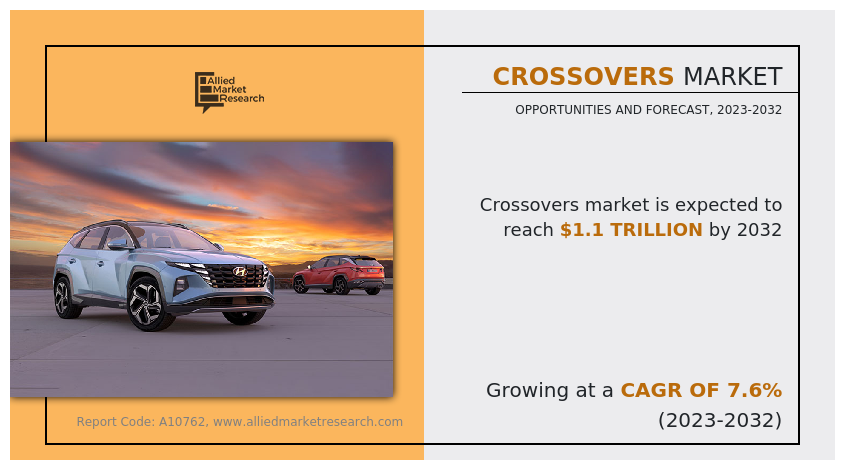
Report Key Highlighters:
- The crossovers market study covers more than 15 countries. The research includes regional and segment analysis of each country in terms of value ($billion) for the projected period 2023-2032.
- The study integrated high-quality data, professional opinions and analysis, and critical independent perspectives. The research approach is intended to provide a balanced view of global markets and to assist stakeholders in making educated decisions in order to achieve their most ambitious growth objectives.
- Over 3,700 product literature, annual reports, industry statements, and other comparable materials from major industry participants were reviewed to gain a better understanding of the market.
Introduction
A crossover vehicle, often referred to as a CUV, is an automotive classification that combines features of both, traditional sport utility vehicles (SUVs) and passenger cars. Characterized by a unibody construction, crossovers typically share design elements with SUVs, such as a higher ground clearance and a versatile interior space, while also incorporating car-like handling and fuel efficiency. This hybrid design aims to provide consumers with a vehicle that blends practicality and cargo capacity associated with SUVs, along with smoother ride and better fuel economy commonly found in traditional sedans. Crossovers have gained popularity due to their adaptability to various driving conditions and the flexibility they offer for both, urban commuting and outdoor activities.
Market Dynamics
The automotive industry is primarily driven by the rising popularity of crossover vehicles. This dynamic segment skillfully blends the robust appeal inherent in sport utility vehicles (SUVs) with the refined attributes traditionally associated with conventional passenger cars. The crossovers are built on a unibody platform, and these vehicles hold the structural robustness of traditional SUVs with the streamlined aesthetics and driving dynamics of passenger cars. These vehicles are built to cater to the multifaceted lifestyles of consumers. It offers a versatile solution that seamlessly adapts to the demands of both urban dwellers and avid adventure enthusiasts. The charm of crossovers resides in their innate capacity to effortlessly surpass the constraints of traditional categorization. With a higher ground clearance and ample cargo space reminiscent of SUVs, coupled with the fuel efficiency and flexibility like sedans, crossovers embody the proverbial best of both worlds. This inherent duality positions them as the vehicular chameleons of our time, effortlessly navigating the urban jungle while also conquering off-road terrains with poise.
Compact crossovers market trends are fueled by various factors that drive their growth and present unique opportunities. A prominent trend revolves around increase in consumer preference for compact yet versatile vehicles, as urbanization rises, and drivers seek maneuverability without compromising on functionality.
The growth of the compact crossovers segment is further propelled by a heightened emphasis on fuel efficiency and environmental consciousness. As consumers prioritize eco-friendly options, compact crossovers, with their efficient designs and often advanced powertrains, become a compelling choice in the market. The trend aligns with a broader global shift towards greener transportation alternatives.
Urbanization and desire for adaptable vehicles have led to surge in the popularity of mid-size crossovers, with consumers appreciating their balanced proportions and spacious interiors. Rise in trend towards advanced safety features and connectivity options further drives the growth of the segment.
Manufacturers are integrating innovative technologies, such as driver-assistance systems and smart infotainment, to meet the evolving expectations of mid-size crossover enthusiasts. Moreover, a growing emphasis on eco-friendly options has led to the introduction of hybrid and electric powertrains within this segment, aligning with the global push towards sustainability.
Market Segmentation
The global crossovers market is segmented by type, by propulsion, by gear transmission, and by region. On the basis of type, the market is divided into compact crossovers, mid-size crossovers, and full-size crossovers. By propulsion, it is bifurcated into ICE and electric. By gear transmission, the segment is divided into manual, and automatic. Region wise, the market is analyzed across North America, Europe, Asia-Pacific, and LAMEA.
In North America, consumers appreciate the elevated seating positions and commanding road presence that crossovers offer. This attribute, combined with a spacious interior and flexible cargo space, aligns with the preferences of families, urban commuters, and adventure enthusiasts alike. As people incline towards vehicles that seamlessly transition between city streets and outdoor escapades, crossovers have become the vehicle of choice, contributing to their widespread popularity.
The crossover is supported by the advancements in safety technology and connectivity features. Modern crossovers are equipped with advanced safety systems, infotainment options, and connectivity features that resonate with the preferences of contemporary consumers who seek not only reliable transportation but also a tech-savvy driving experience.
In Europe, a rise in demand for crossovers is reshaping the automotive market, driving a significant increase in crossover sales. The versatile design of crossovers resonates with European consumers, offering a harmonious blend of compact efficiency and SUV-like functionality. Elevated seating positions provide a commanding view of European roads, while the spacious interiors cater to diverse lifestyles.
Rise in crossover sales is attributed to the adaptability of these vehicles to urban environments and the practicality they offer for families, contributing to their widespread popularity across the continent. European consumers, known for their appreciation of fuel efficiency and environmental consciousness, find crossovers to be an ideal choice that aligns with their values. As the manufacturers continue to diversify their crossover offerings, the European market is witnessing a surge in sales, driven by the versatility and broad consumer appeal that crossovers bring to the table.
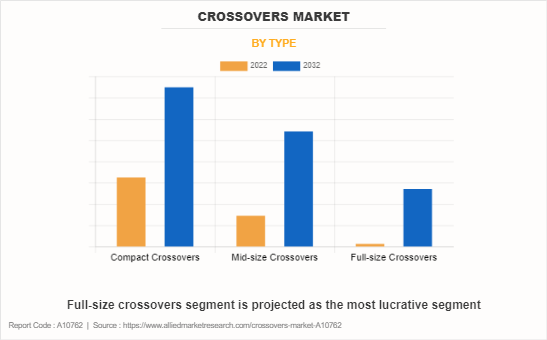
Which are the Top Crossover companies
The following are the leading companies in the market. These players have adopted various strategies to increase their market penetration and strengthen their position in the crossover industry.
- Nissan Motor Co., Ltd.
- Tata Motors
- Mazda Motor Corporation
- Subaru of America, Inc.
- TOYOTA MOTOR CORPORATION
- Volkswagen Group
- Kia Corporation
- MITSUBISHI MOTORS CORPORATION
- Ford Motor Company
- Hyundai Motor Group
What are the Top Impacting Factors
Key Market Driver
Changes in Family Structures to Impact Positively to Crossovers Market
Changes in family structures have emerged as a powerful influencer with a positive impact on the crossovers market, reshaping the automotive industry to meet the evolving needs and preferences of diverse households. As societal structures undergo transformations, the automotive industry is witnessing a significant shift in the types of vehicles that families are seeking, and crossovers are at the forefront of this evolution.
Rise in diverse family compositions is another noteworthy change in family structures. Modern families come in various sizes and formats, ranging from nuclear families to single-parent households. This diversity necessitates a versatile mode of transportation that can seamlessly adapt to different family dynamics. Rise in prevalence of single-parent households is also contributing to the positive impact on the crossovers market. Single parents often seek vehicles that balance practicality with style and comfort, and crossovers fit this criterion exceptionally well. The combination of ample cargo space, user-friendly features, and a higher driving position appeals to single parents looking for a vehicle that caters to their family's needs while aligning with their individual preferences.
The positive impact of changes in family structures on the crossovers market demand underscores the adaptability and versatility of these vehicles. Crossovers have positioned themselves as the go-to choice for families of various sizes and compositions, catering to the unique requirements of contemporary households. As family structures continue to evolve, crossovers industry is poised to maintain their positive trajectory, providing a driving solution that seamlessly integrates with the diverse lifestyles of modern families.
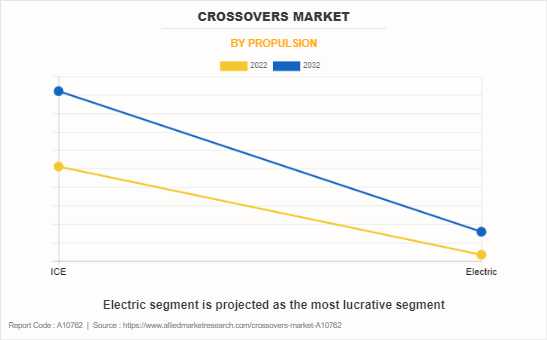
Evolution of Safety Technologies Drive Crossover Market Growth
Rise in success of the crossovers industry is significantly propelled by the evolution of safety technologies. As automotive safety standards progress, consumers are placing a growing emphasis on vehicles equipped with advanced safety features, and crossovers are meeting this demand by incorporating innovative technologies that enhance both active and passive safety measures. A key driver in advancing the crossovers market is the seamless integration of advanced driver-assistance systems (ADAS).
The integration of advanced safety features is also crucial for meeting and exceeding government regulations. Stricter rules and regulations regarding vehicle safety are encouraging automakers to invest in the development and implementation of innovative safety technologies. Crossovers, being a popular choice among a broad demographic, are at the forefront of this safety evolution. Manufacturers are actively responding to regulatory requirements by enhancing safety features, ensuring that their crossover models not only meet but often surpass safety standards.
Moreover, the evolution of safety technologies extends beyond collision prevention. Crossovers now come equipped with advanced technologies, including surround-view cameras, parking sensors, and cross-traffic alert systems. These features not only enhance the safety of occupants but also contribute to the overall convenience and driving ease, making crossovers an appealing choice for a broad spectrum of consumers.
Crossovers, with their commitment to integrating the latest safety advancements, not only meet current consumer expectations but are also well-positioned to anticipate and adapt to the evolving safety landscape. This commitment to safety innovation positions crossovers as vehicles that not only offer versatility and style but also prioritize the well-being and security of their occupants, ensuring a sustained positive trajectory for the crossovers market.
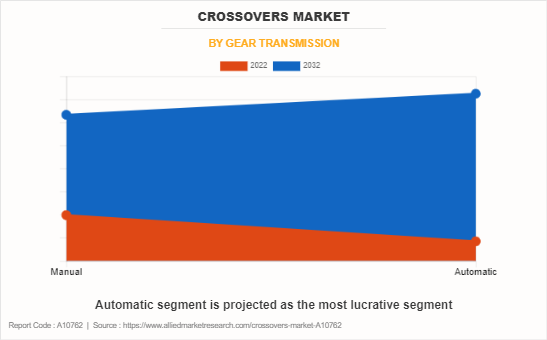
Restraints
Competition from Other Vehicle Segments
Crossovers find themselves in a tussle for consumer attention with traditional SUVs, which boast larger frames and a more pronounced off-road capability. This intense rivalry does impact the growth trajectory of the crossovers market, especially as consumers weigh the attraction of a full-fledged SUV against the more compact and urban-friendly design of a crossover. The challenge lies in conveying the unique value proposition of crossovers, emphasizing their adaptability to diverse lifestyles, and driving conditions.
Moreover, the market contends with competition from smaller vehicles, such as compact cars and sedans, which appeal to consumers seeking fuel efficiency and a more budget-friendly option. The allure of lower upfront costs and potentially better fuel economy can divert consumers away from crossovers, particularly in regions where economic considerations play a pivotal role in purchasing decisions. This price sensitivity poses a restraint on the crossovers market, necessitating strategic marketing efforts to highlight the long-term benefits and versatile features that crossovers offer.
Efforts to differentiate crossovers from other segments extend beyond price considerations. Emphasizing the blend of functionality and style that crossovers offer can resonate with consumers looking for a vehicle that aligns with their lifestyle. Marketing campaigns showcases the adaptability of crossovers to both urban and suburban environments, as well as their suitability for various family sizes, can help carve a distinct niche in the face of competition. While crossovers had significant popularity, the competition from other vehicle segments underscores the need for nuanced strategies in positioning and marketing. Navigating this competitive landscape requires highlighting the unique advantages of crossovers, addressing consumer perceptions, and continually innovating to stay ahead in a market where choices abound. As the automotive industry evolves, crossovers find ways to stand out in a crowded field, ensuring their continued relevance and appeal to a diverse consumer base.
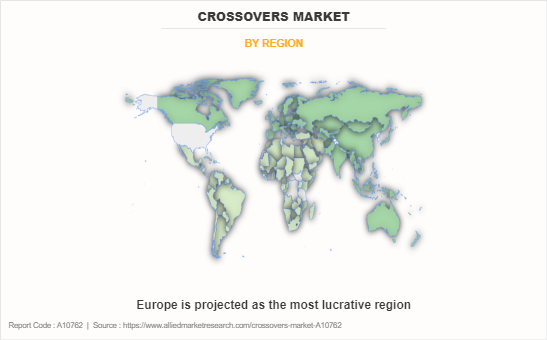
Opportunity
Hybrid and Plug-In Hybrid Models to create lucrative opportunities
The infusion of hybrid and plug-in hybrid models into the crossovers market represents a strategic opportunity, marking a harmonious convergence between technological advancements and consumer preferences. Against the backdrop of a profound transformation in the automotive sector towards more sustainable options, the ascent of hybrid and plug-in hybrid crossovers not only aligns with the escalating demand for fuel efficiency but also opens lucrative avenues for manufacturers to amplify sales and fortify their foothold in the market.
Plug-in hybrid crossovers, taking the hybrid concept a step further by allowing users to charge their vehicles through external power sources, present an even more enticing prospect. This innovation caters to the growing infrastructure for electric vehicle charging and provides consumers with the flexibility to operate in electric-only mode for shorter commutes. The ability to switch between conventional and electric power sources based on driving needs offers a level of versatility that resonates with the diverse lifestyles of crossover enthusiasts.
The increase in the sales of hybrid and plug-in hybrid crossovers can be attributed to their dual advantages, notably improved fuel efficiency and a diminished environmental impact. As governments and consumers across the globe entirely adopt the shift towards cleaner transportation, the opportunity for automakers to seize upon this trend is considerable. Manufacturers who invest in the development and marketing of hybrid crossover models position themselves at the forefront of this transformative wave, tapping into a market segment that values both eco-conscious choices and the versatile adaptability of crossovers.
What are the Recent Developments in the Crossover Market
The leading companies are adopting strategies such as acquisition, agreement, expansion, partnership, contracts, and product launches to strengthen their market position.
In October 2023, Mitsubishi Motors Corporation launched Mitsubishi D:X Concept electrified crossover MPV. The design features large-diameter tires, sturdy over fenders, and front and rear skid plates for off-road performance under rough conditions. The car features a raked front windscreen, moonroof, LED laser projector headlights, mud-terrain tires, and rugged black plastic flares at each wheel.
In September 2023, Nissan Motor Co., Ltd. launched a series of exciting all-electric concept vehicles, Nissan Hyper Urban crossover. The Nissan Hyper Urban's styling perfectly complements its target users, such as urban- and suburban-based professionals who prioritize environmental sustainability.
In July 2023, Toyota Motor Corporation launched second-generation C-HR crossover. The new C-HR has the powertrain line-up as the Prius: a 2.0-litre plug-in hybrid alongside 2.0-litre andamp; 1.8-litre parallel hybrids.
In April 2022, Kia Corporation developed EV6 electric crossover andamp; planned to launch in India. Before EV, company sells models like Seltos and Sonet in India. The newly developed EV designed from the ground up to make electric mobility fun, convenient, and accessible by combining a highly impressive real-world driving range.
Key Benefits for Stakeholders
- This report provides a quantitative analysis of the market segments, current trends, estimations, and dynamics of the crossovers market analysis from 2022 to 2032 to identify the prevailing market opportunities.
- The market research is offered along with information related to key drivers, restraints, and opportunities.
- Porter's five forces analysis highlights the potency of buyers and suppliers to enable stakeholders make profit-oriented business decisions and strengthen their supplier-buyer network.
- In-depth analysis of the market segmentation assists to determine the prevailing market opportunities.
- Major countries in each region are mapped according to their revenue contribution to the global market.
- Market player positioning facilitates benchmarking and provides a clear understanding of the present position of the market players.
- The report includes the analysis of the regional as well as global market trends, key players, market segments, application areas, and market growth strategies.
Crossovers Market Report Highlights
| Aspects | Details |
| Market Size By 2032 | USD 1.1 trillion |
| Growth Rate | CAGR of 7.6% |
| Forecast period | 2022 - 2032 |
| Report Pages | 325 |
| By Type |
|
| By Propulsion |
|
| By Gear Transmission |
|
| By Region |
|
| Key Market Players | TOYOTA MOTOR CORPORATION, Volkswagen Group, Mazda Motor Corporation, Tata Motors, Subaru of America, Inc., MITSUBISHI MOTORS CORPORATION, Nissan Motor Co., Ltd., Ford Motor Company, Kia Corporation, Hyundai Motor Group |
Hybrid & plug-in hybrid models, and expanding into luxury crossover segment are the upcoming trends of Crossovers Market in the world.
The market size of crossovers market is $541.0 billion in 2022.
Asia-Pacific is the largest regional market for crossovers.
The estimated industry size of crossovers in 2032 is $1.1 trillion.
Compact crossovers is the leading segment by type in crossovers market.
Loading Table Of Content...
Loading Research Methodology...



